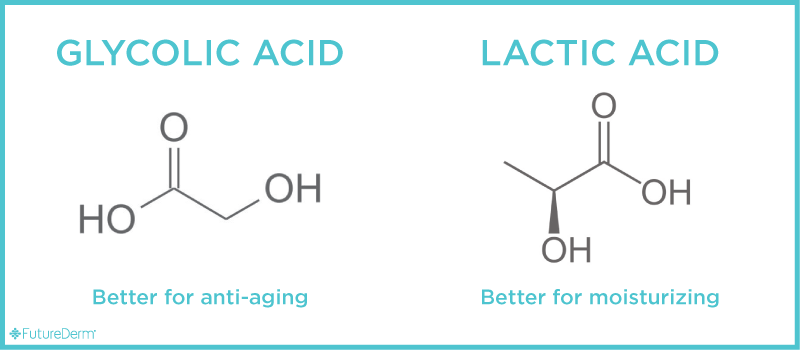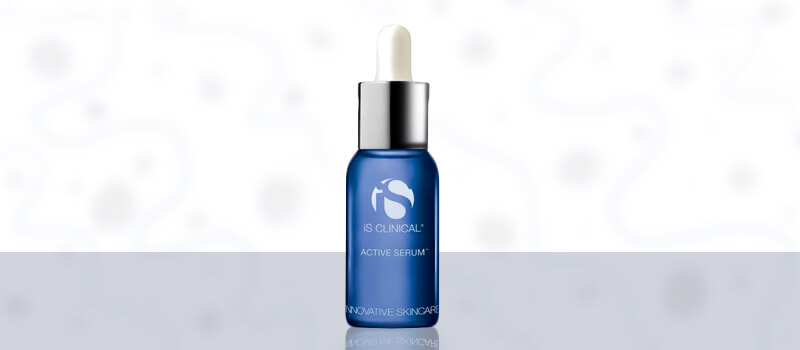What does Glycolic acid do?
Glycolic acid is the most common of all the alpha hydroxy acids. Glycolic acid peels advance desquamation and thinning of the stratum corneum (the uppermost layer of the skin). By exfoliating the top layer of the skin, glycolic acid peels smooth the skin, quicken the rate of cell turnover (which is reduced by up to 7% every ten years), decrease small wrinkles and increase the fibroblast proliferation of collagen.
Glycolic acid is the smallest of the alpha hydroxy acids (AHAs) and is a common ingredient in skincare ingredients. Both in vitro and in vivo tests have shown it to increase collagen production, fibroblast proliferation, and cell turnover rates (Dermatologic Surgery).
[Related: Spotlight On: Alpha Hydroxy Acids]
Glycolic acid acts as both a moisturizer and an exfoliator; it increases the skin’s supply of hyaluronic acid, which can hold 1000 times its weight in water, thus making glycolic acid a humectant. It also exfoliates by increasing the separation of skin cells, a process calledcorneocyte desquamation, resulting in even more cell turnover! And you know what that means: smoother, more elastic skin (Skin Therapy Letter)!
Keep in mind: The higher the value, the more biologic activity, and the more sensitive your skin is to sun (Skin Therapy Letter). This makes B. Kamins Glycolic 10 a reasonable product for the summer months, as opposed to its in-office competitors, which can range from 30-70%.
Is Glycolic Acid Effective at Over-the-Counter Concentrations?
A glycolic acid peel, known as “the lunchtime peel” because it can be completed over a patient’s lunch hour, and often inconspicuously, is available from the dermatologist in concentrations ranging from 20 percent to 70 percent (pH as low as 3.0). Most dermatologists recommend that the patient undergo a series of six weekly treatments at a cost of $150-$200 per peel, and gradually building up the concentration and contact time with each peel. Baumann notes that it usually takes at least four peels for noticeable improvement of photodamage, solar lentigos, and melasma to occur. However, both treatment and results may vary based upon the patient.
At rates of 15%, it takes at least four peels for for noticeable improvement of photodamage, solar lentigos, and melasma to occur (Baumann). You may also not expect the complete reversal of moderate to severe wrinkling or scarring (Baumann). That said, NEOVA Serious Gly-Peel Peel-Off Masque is an absolutely genius product for those with mild to moderate wrinkling, age spots, and/or issues with skin dullness. Use it once or twice a week for no longer than 10-15 minutes to reveal bright, glowing skin. (That sounds really marketing-rich, but it works.)
Glycolic acid is also available in at-home treatments in 8 to 15 percent concentrations (pH about 3.5 or higher); it is typically diluted with anti-irritating ingredients in a mild formula. At these low concentrations, Baumann notes that the patient should not expect reversal of moderate to severe wrinkling or scarring. In fact, according to a randomized, placebo-controlled double-blind study, it was found that 0.05% all-trans-retinoic acid was more effective than 2% lipoic acid or 10% glycolic acid (a concentration found in at-home treatments) in treating signs of aging. The user should also be cautious of irritation with at-home treatments. Baumann cites a study by Yu et. al which found that certain other ingredients in formulations containing AHAs cause irritation, rather than the AHAs themselves. The buyer is thereby advised to be extremely cautious in selecting proper at-home glycolic acid treatments. Dr. Bank recommends NeoStrata Skin Smoothing Cream with 8 percent glycolic acid and Aqua Glycolic Face Cream ($17.49, Drugstore.com).
What is lactic acid? How do its effects differ from glycolic acid?

Lactic acid, extracted from milk but usually found in synthetic form in most cosmetics, is another popular AHA, but unlike glycolic acid, it is primarily used in out-of-office treatments. One source of lactic acid is in LacHydrin, a prescription drug FDA approved to treat (surprise!) dry skin, not signs of aging, although the latter is also assisted with LacHydrin use. The fact that LacHydrin does both makes it an excellent recommendation for post-menopausal women, who often experience dry skin and signs of aging. For anti-aging treatments, glycolic acid is usually preferred to lactic acid because it has a smaller molecular structure, which allows it to easily and efficiently penetrate the skin, and also because glycolic acid increases the thickness and firmness of the skin, but lactic acid does not.
Don’t lactic acid and glycolic acid cause skin dryness?
Despite popular belief, it seems that lactic acid and glycolic acid do not cause skin dryness or irritation; rather, it is often the formulation (i.e., the other ingredients) of the AHA treatment that is the source of discomfort, as found in a previously mentioned study by Yu et. al. A second Baumann-cited study found that transepidermal water loss (TEWL) is not altered by application of AHAs. In fact, AHAs are humectants that increase the ability of the skin to hold onto water, as evidenced by the fact that lactic acid is the main ingredient in LacHydrin, an FDA-approved drug for the treatment of dry skin. One probable reason AHAs are commonly blamed for dry skin and irritation is because stronger peels, such as the deep phenol or medium depth trichloracetic acid (TCA) peels, often cause skin sensitivity and irritation. However, typical strength glycolic and lactic acid peels are actually considered “superficial,” usually without many of the side effects of medium-and-deep strength or laser treatments.
Do AHAs make skin more photosensitive or thin the skin?
AHAs have been found to thin the epidermis, and make skin more photosensitive. A Baumann-cited study conducted by Tsai et. al found that pre-treatment with 10% glycolic acid caused an increase in UVB sensitivity in white and Asian subjects, and an increase in UVA sensitivity in Asian subjects. This is a clear indication that AHAs must be used with regular sun protection.
The epidermis is thinned after use of AHAs. However, interestingly, the overall thickness of the skin is increased after use of glycolic acid, as treatment has been shown to increase expression of Type 1 Collagen mRNA and hyaluronic acid content in the dermis of the skin. However, after lactic acid treatment, a 1996 study by Smith et. al found no change in dermal thickness or firmness.
What are the Best Products with Glycolic Acid?
Best for Every Regimen and Skin Type: NEOVA Glypeel Peel-Off Mask
People often ask me how they can add an alpha hydroxy acid into their existing skin care regimen, whether because their regimen is so acidic already and they’re afraid of burning their faces, or because their regimen contains retinoids and an acidic product would take the product out of its optimal pH range for activation.
Enter NEOVA Glypeel Peel-Off Mask. A once-or-twice a week phenomenon, NEOVA Serious Gly-Peel Peel-Off Masque is a fantastic product for treating fine lines, wrinkles, mottled or rough skin, and sun-damaged skin. (Though, keep in mind, you do NOT want to apply it directly to sunburned skin!). It dries quickly and feels amazing, leaving skin with a glow. Use it once or twice in a week, then follow up with a normal cleansing, toning, and moisturizing regimen. (Ignore retinoids or other AHA treatments on the same night to avoid deactivation or irritation, respectively). A true sensation.
Best for Resistant/Strong Skin Types: Skin Laboratory 30% Glycolic Acid Peel (Professional Strength)
If you’re the type who’s not afraid of a challenge, enter Skin Laboratory 30% Glycolic Acid Peel ($38.95, Amazon.com).
This product is best for those who do NOT have oily, acne-prone, or sensitive skin. Those with oily and acne-prone skin may find that their skin “retriggers” oil production after using the product. As for those with sensitive skin, you know what happens: You use the product, you get irritated to the max.
With 30% glycolic acid, you MUST follow the instructions exactly, rinsing off thoroughly after 10-15 minutes. That said, the concentration of glycolic acid in this product will leave your skin smooth and significantly less lined. I recommend this for use no more than once/week.
Best for Skin Brightening: iS Clinical Active Serum
iS Clinical Active Serum is a very solid product for fighting hyperpigmentation – age spots, melasma, and the like, with not only glycolic and lactic acids, but also with kojic acid.
Now, when I think of potent skin brighteners, I never used to think of kojic acid. However, the data has convinced me otherwise: In two studies by scientists Ellis and Garcia, kojic acid combined with glycolic acid has been found to be more effective than 10% glycolic acid or 4% hydroquinone for the treatment of hyperpigmentation.
In a third study, 2% kojic acid in combination with 10% glycolic acid and 2% hydroquinone also was found to improve melasma symptoms over a mixture of 10% glycolic acid and 2% hydroquinone alone.
In other words, even though we don’t think of kojic acid as one of the “big guns” in fighting hyperpigmentation, the data says we should start to do so. While iS Clinical Active Serum contains only 0.5% kojic acid, in combination with the deep-penetrating formulation and alpha hydroxy acids, this is a potent age spot fighter indeed.
Best for Sensitive Skin: My Beauty Bunny AHA Moisturizer/Masque
Yep, I formulated this product myself for my friend Jen at My Beauty Bunny, so I am biased! But it is a sensational moisturizer or masque for those with sensitive skin.
With 5% alpha hydroxy acid (AHA) sourced exclusively from all-natural fruit acids, MyBeautyBunny All-Original My Beauty Bunny Cruelty-Free All-Natural AHA Moisturizer contains an original blend of soothing aloe, toning witch hazel, moisturizing squalane (from olives), bilberry fruit, sugar cane, sugar maple, orange fruit extract, lemon fruit extract; and antioxidants: camellia oleifera (white tea), camellia sinensis (green tea), and aspalathus linearis (AKA rooibus or “red tea”). Made with a light berry grapefruit scent as well!
Yes, you can either apply the lotion as a leave-on product, or apply a thicker layer and rinse off after 10 minutes. It works really well.
Bottom Line
Glycolic acid is one of the best ingredients for anti-aging prevention and treatment out there, proven to exfoliate, improve the appearance of fine lines and wrinkles, and (most likely) stimulate collagen growth over time. To get the full benefits, I recommend one of the following:
- NEOVA Serious Gly-Peel Peel-Off Masque (for most skin types)
- iS Clinical Active Serum (for hyperpigmentation)




